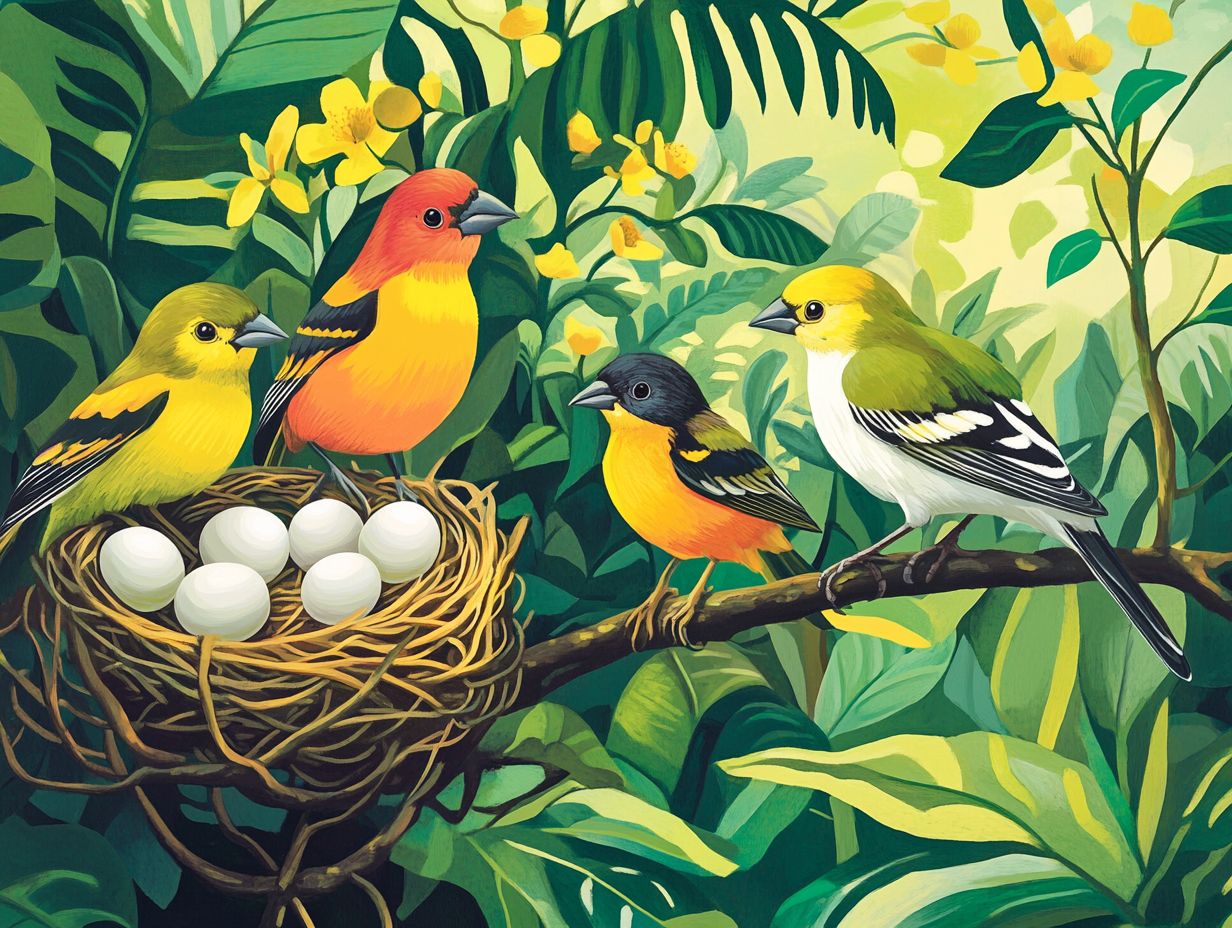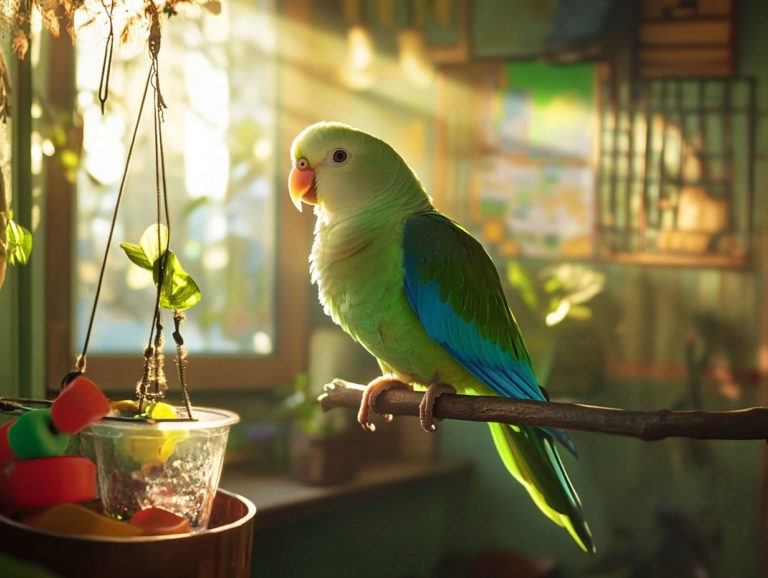Understanding the Life Cycle of Finches
Finches are more than just vibrant songbirds; they embody a world of intriguing secrets within their life cycles that reveal their remarkable survival and adaptability.
From the delicate journey of egg development to the devoted care displayed by their parents and the exhilarating moment of fledging, each stage is crucial in shaping their future.
This article delves into these captivating phases, examining the environmental factors that impact their lives and the essential conservation efforts aimed at safeguarding these delightful creatures.
Dive in now to discover the amazing lives of finches and the challenges they face!
Contents
Key Takeaways:

- Finches go through a life cycle that includes stages of egg development, nesting, fledging, and independence.
- The life cycle of finches can be influenced by environmental and behavioral factors that affect their survival and reproduction.
- Conservation efforts for finches involve addressing threats to their habitat and implementing protection strategies with the help of conservationists and researchers.
Overview of the Species
The House Finch (Haemorhous mexicanus) is a remarkably adaptable songbird found throughout North America, especially in Canada and Mexico. These little wonders thrive in a wide array of human-created environments, from bustling urban centers to quiet residential areas.
With their captivating nesting behaviors and cheerful vocalizations, it’s no surprise they ve become a favorite among birdwatchers and conservationists alike.
Watch as these lively birds flock together, creating a vibrant display of social interaction! They communicate through cheerful chirps and melodic songs, showcasing strong social connections.
They prefer semi-open spaces like gardens and parks, where they feast on seeds and fruits that make up a significant portion of their diet.
House Finches display fascinating breeding habits, often nesting close to human dwellings, which makes them more visible to those who appreciate their beauty. However, despite their remarkable adaptability, they face several conservation challenges, including habitat loss and competition with other species.
Observing these delightful finches not only offers a glimpse into urban ecology but also highlights the importance of preserving diverse habitats for all wildlife.
Life Cycle of Finches
The life cycle of House Finches unfolds in several pivotal stages, beginning with captivating courtship displays during the breeding season. You ll observe the fascinating intricacies of their nesting behavior and the attentive parental care that follows, culminating in the fledging of their young.
This remarkable cycle showcases their remarkable adaptability to human-altered habitats and underscores their ecological importance in urban settings.
Egg Development and Hatching
House Finch eggs are typically small and speckled, with the female incubating them for about 12 to 14 days before they hatch. These characteristics are essential to how they ensure their eggs hatch and survive.
During this critical period, the female depends on a steady supply of food to maintain her health and support the developing young finches.
The unique coloration and size of the eggs help them blend seamlessly into their surroundings for added protection. As incubation progresses, the female frequently forages, seeking a diet rich in seeds, fruits, and flowers to fuel her energy needs.
Nest construction is another captivating aspect of their behavior. The female employs various materials, including twigs, grass, and even bits of human debris, to craft a secure environment for her clutch. This nesting behavior highlights the species’ adaptability, enabling them to thrive in diverse habitats while ensuring optimal conditions for their offspring.
Nesting and Parental Care

House Finches show remarkable adaptability in nesting, especially in urban settings. They choose various locations for their nests and both parents play a vital role in caring for their young.
Their nests consist of twigs, feathers, and bits of human debris. This showcases their resourcefulness in urban landscapes.
Both male and female House Finches share parenting duties. This collaboration enhances the survival of their young and helps maintain ecological balance.
Fledging and Independence
Fledging, which means the young birds leave the nest for the first time, is a crucial moment for young House Finches. It marks their shift from dependent nestlings to independent birds ready to search for food.
As they leave the nest, they face many challenges. The world outside is full of unfamiliar sounds and potential threats.
During this time, they build social structures and bond with siblings. These connections help them navigate their environment more effectively.
The race for food can be fierce during fledging, pushing these young birds to sharpen their skills!
Factors Affecting the Life Cycle
Several factors shape the life cycle of House Finches. These include environmental adaptations, food availability, and climate impacts.
Understanding these influences helps you grasp the ecological dynamics in urban ecosystems where these finches thrive.
Environmental and Behavioral Influences
Environmental and behavioral factors greatly influence House Finch populations. These factors affect their social hierarchy and survival traits.
The availability of food resources directly shapes their foraging behavior and social interactions. Urban environments often change these dynamics.
While these birds adapt well, changes in weather or habitat destruction can impact their distribution and reproductive success. Monitoring these factors is vital for assessing their health.
Conservation Efforts for Finches

Conservation efforts for House Finches focus on vigilant population monitoring and addressing urgent conservation challenges, particularly regarding their health and the impact of diseases like mycoplasmal conjunctivitis, a contagious eye disease affecting birds.
Esteemed organizations such as the Audubon Society and Cornell Lab of Ornithology play crucial roles in conducting research and developing strategic initiatives to protect these resilient songbirds in urban settings.
Threats and Protection Strategies
House Finches face several significant threats that endanger their populations, including outbreaks of disease and habitat loss. It s essential to understand these challenges to create effective conservation strategies that mitigate their decline.
Recognizing these threats helps create targeted protection measures. This ensures the long-term survival of this adaptable songbird.
One pressing issue is the spread of viral infections like Mycoplasma gallisepticum, which can severely affect their health and reproductive success. Urban development and climate change also threaten their habitats, leading to a reduction in available food and nesting sites.
To combat these pressures, conservationists advocate for habitat restoration, public education on identifying signs of wildlife diseases, and community initiatives to create urban green spaces. Let s save these vibrant birds! Every effort counts in ensuring their survival and well-being.
Role of Conservationists and Researchers
Conservationists and researchers are vital for understanding the ecological roles of House Finches, as they carefully watch their populations through initiatives like the breeding bird survey. Their work is important for implementing effective conservation measures to address the challenges faced by this adaptable species.
By employing a blend of field studies, banding techniques, and studying genes, they gather extensive data on habitat preferences, breeding behaviors, and migration patterns. Their findings illuminate how urban environments shape the adaptability and survival of House Finches, guiding strategies that enhance their resilience against urbanization and climate change.
The collaboration between citizen scientists and professional ornithologists in these studies highlights the importance of public involvement in conservation efforts. Such partnerships enrich the data collected and foster a deeper appreciation for local biodiversity, contributing meaningfully to the broader goals of ecological preservation and species protection.
Frequently Asked Questions
Curious about finches? Here s what you need to know!
What is the life cycle of finches?

The life cycle of finches includes stages of development from birth to adulthood: the egg stage, chick stage, juvenile stage, and adult stage.
How long does it take for finches to hatch from their eggs?
The incubation period for finch eggs varies by species, but it typically takes around 12-14 days for the eggs to hatch. During this time, the parents take turns keeping the eggs warm and safe.
What do finch chicks eat?
After hatching, finch chicks are primarily fed insects and worms by their parents. As they grow, their diet transitions to include more seeds and fruits.
When do finches reach sexual maturity?
Finches usually reach sexual maturity at around 9-12 months of age. At this stage, they are considered adults and are capable of reproducing.
How many times a year do finches typically breed?
Finches can breed multiple times a year, depending on food and resource availability. Some species may breed up to four times in a single year.
How Long Do Finches Live?
Finches typically live between 2 to 7 years in the wild, depending on the species. In a safe home, they can live longer because they have no predators and constant access to food and shelter.
Understanding how to care for finches can help you enjoy their company for many years. Make sure to provide them a safe environment to keep them healthy and happy!






